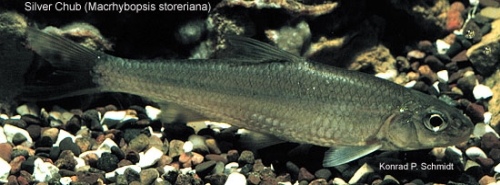Plants and Animals
Macrhybopsis storeriana Silver chub
Key Characteristics
The silver chub is a slender, bright silver minnow with a fairly compressed body. Its barbell is in the corner of its subterminal mouth. It has a large eye on the upper half of its head and a short, rounded snout.
Status and Rank
US Status: No Status/Not Listed
State Status: T - Threatened (legally protected)
Global Rank: G5 - Secure
State Rank: S1 - Critically imperiled
Occurrences
| County | Number of Occurrences | Year Last Observed |
|---|---|---|
| Macomb | 1 | 1979 |
| Monroe | 4 | 2017 |
| St. Clair | 2 | 1985 |
| Wayne | 3 | 1985 |
Information is summarized from MNFI's database of rare species and community occurrences. Data may not reflect true distribution since much of the state has not been thoroughly surveyed.
Habitat
Silver chubs are typically found in deep waters of low-gradient streams and rivers as well as in lakes. This species prefers pools with clean sand and fine gravel substrates but will move into riffles to avoid silt. However, they have been found in silty areas but it is unknown if they will survive for long periods in silt (Smith 1979, Scott and Crossman 1973). In lakes, they are found at depths less than 10 m.
Specific Habitat Needs
Often deeper habitats, 9-12 m needed in: River (5th-6th order), pool; River (5th-6th order), run.
Natural Community Types
- River (5th-6th order), pool
- River (5th-6th order), run
For each species, lists of natural communities were derived from review of the nearly 6,500 element occurrences in the MNFI database, in addition to herbarium label data for some taxa. In most cases, at least one specimen record exists for each listed natural community. For certain taxa, especially poorly collected or extirpated species of prairie and savanna habitats, natural community lists were derived from inferences from collection sites and habitat preferences in immediately adjacent states (particularly Indiana and Illinois). Natural communities are not listed for those species documented only from altered or ruderal habitats in Michigan, especially for taxa that occur in a variety of habitats outside of the state.
Natural communities are not listed in order of frequency of occurrence, but are rather derived from the full set of natural communities, organized by Ecological Group. In many cases, the general habitat descriptions should provide greater clarity and direction to the surveyor. In future versions of the Rare Species Explorer, we hope to incorporate natural community fidelity ranks for each taxon.
Management Recommendations
To effectively manage for preferred habitats of the silver chub a watershed approach to minimize sediments and nutrient inputs is needed. Threats to this species need to be resolved.
Active Period
Spawning from first week of May to fourth week of June
Survey Methods
Trawls
Survey Period: From first week of April to fourth week of September
Umbrella nets
Survey Period: From first week of April to fourth week of September
References
Survey References
- Murphy, B.R. and D.W. Willis, eds. 1996. Fisheries Techniques, 2nd ed. American Fisheries Society, Bethesda. 732pp.
Technical References
- Bailey, R.M., W.C. Latta, and G.R. Smith. 2004. An Atlas of Michigan Fishes. Museum of Zoology, University of Michigan, No. 192, Ann Arbor. 215p.
- Derosier, A.L. 2004. Special Animal Abstract for Macrhybopsis storeriana (Silver chub). Michigan Natural Features Inventory, Lansing, MI. 2pp.
- Page, L. M. and B.M. Burr. 1991. A field guide to freshwater fishes: North America north of Mexico. Houghton Mifflin Company, Boston. 432pp.
- Parker, B., P. McKee, and R.R. Campbell. 1987. Status of the silver chub, Hybopsis storeriana, in Canada. Canadian Field-Naturalist 101(2):190-194.
- Scott, W.B. and E.J. Crossman. 1973. Freshwater fishes of Canada. Bulletin 184, Fisheries Research Board of Canada, Ottawa. 966pp.
- Smith, C.L. 1985. The inland fishes of New York State. New York State Department of Environmental Conservation, Albany. 522pp.
- Trautman, M.B. 1981. The Fishes of Ohio. Ohio State University Press, Columbus. 782pp.


